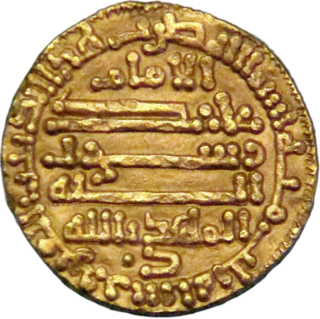
Abd Allah ibn Abi Quhafa, commonly known by the kunyaAbu Bakr, was the first caliph, ruling from 632 until his death in 634. A close companion and father-in-law of Muhammad, Abu Bakr is referred to with the honorific title al-Ṣiddīq by Sunni Muslims.
Shia Islam is the second-largest branch of Islam. It holds that the Islamic prophet Muhammad designated Ali ibn Abi Talib (656–661 CE) as his successor as Imam, most notably at the event of Ghadir Khumm, but that after Muhammad's death, Ali was prevented from succeeding as leader of the Muslims as a result of the choice made by some of Muhammad's other companions at Saqifah. This view primarily contrasts with that of Sunni Islam, whose adherents believe that Muhammad did not appoint a successor before his death and consider Abu Bakr, who was appointed caliph by a group of Muhammad's other companions at Saqifah, to be the first Rashidun ('rightful') caliph after Muhammad (632–634 CE).
In Shia Islam, the Imamah is a doctrine which asserts that certain individuals from the lineage of the Islamic prophet Muhammad are to be accepted as leaders and guides of the ummah after the death of Muhammad. Imamah further says that Imams possess divine knowledge and authority (Ismah) as well as being part of the Ahl al-Bayt, the family of Muhammad. These Imams have the role of providing commentary and interpretation of the Quran as well as guidance.

Zaydism is one of the three main branches of Shia Islam that emerged in the eighth century following Zayd ibn Ali's unsuccessful rebellion against the Umayyad Caliphate. Zaydism is typically considered to be a branch of Shia Islam that comes closest to the Sunni, although the "classical" form of Zaydism over the centuries had changed its posture with regard to Sunni and Shia traditions multiple times, to the point where interpretation of Zaydi as Shia is often based on just their acceptance of Ali as a rightful successor to the Islamic prophet Muhammad. Mainstream ("twelver") Shia sometimes consider Zaydism to be a "fifth school" of Sunni Islam. Zaydis regard rationalism as more important than Quranic literalism and in the past were quite tolerant towards Sunni Shafi'ism, a religion of about half of the Yemenis.

A caliphate is an institution or public office under the leadership of an Islamic steward with the title of caliph, a person considered a political–religious successor to the Islamic prophet Muhammad and a leader of the entire Muslim world (ummah). Historically, the caliphates were polities based on Islam which developed into multi-ethnic trans-national empires.

Abū Muḥammad ʿAbd Allāh ibn al-Ḥusayn, better known by his regnal name al-Mahdī biʾllāh, was the founder of the Isma'ili Fatimid Caliphate, the only major Shi'a caliphate in Islamic history, and the eleventh Imam of the Isma'ili branch of Shi'ism.

The Alids are those who claim descent from Ali ibn Abi Talib, the fourth Rashidun caliph and the first imam in Shia Islam. Ali was also the cousin and son-in-law of the Islamic prophet Muhammad. The main branches are the Hasanids and Husaynids, named after Hasan and Husayn, the eldest sons of Ali from his marriage to Fatima, the daughter of Muhammad. As the progeny of Muhammad, they are revered by all Muslims. The Alids have led various movements in Islam, and a line of twelve Alids are the imams in Twelver Shia, the largest Shia branch.
The issue of succession following the death of the Islamic prophet Muhammad is the central issue in the schisms that divided the early Muslim community in the first century of Islamic history into numerous schools and branches. The two most prominent branches that emerged from these divisions are Sunni and Shia branches of Islam. Sunni Islam asserts that Abu Bakr rightfully succeeded Muhammad through a process of election. In contrast, Shia Islam maintains that Ali ibn Abi Talib was Muhammad's designated successor.

Umar ibn al-Khattab was one of the earliest figures in the history of Islam. While Sunnis regard Umar ibn al-Khattab in high esteem and respect his place as one of the "Four Righteously Guided Caliphs", the Shia do not view him as a legitimate leader of the Ummah and believe that Umar and Abu Bakr conspired to usurp power from Ali. This belief arises from the Incident of Saqifa as well the hadith of the pen and paper. Shia believe that the Sunni view of Umar was created by the later Umayyad dynasty to honour the man that gave power to the first Umayyad ruler and third Sunni Caliph, Uthman. In this way, it gives legitimacy to Umar's consultation that started their own dynasty. Shia believe that the Umayyad view was propagated with lethal force and heavy duress and as time went on, that view became predominant and was cemented by the works of Bukhari.

Ali ibn Abi Talib was the cousin and son-in-law of the Islamic prophet Muhammad. Ali contributed significantly to Islam in its early years and was likely the first male to accept the teachings of Muhammad. Ali is accorded an almost legendary place in Islam as a paragon of virtues, a fount of wisdom, and a fearless but magnanimous warrior. In Shia Islam Ali is regarded as the foremost companion of Muhammad and his rightful successor through divinely-ordained designation at the Ghadir Khumm.

Ali ibn Abi Talib was the cousin and son-in-law of the Islamic prophet Muhammad. Ali contributed significantly to Islam in its early years and was likely the first male to accept the teachings of Muhammad. In Sunni Islam, Ali is recognized as a close companion, a foremost authority on the Quran and Islamic law, and the fountainhead of wisdom in Sunni spirituality. When Muhammad died in 632 CE, Ali had his own claims to leadership, perhaps in reference to Muhammad's announcement at the Ghadir Khumm, but he eventually accepted the temporal rule of the first three caliphs in the interest of Muslim unity. During this period, Ali is portrayed in Sunni sources as a trusted advisor of the first three caliphs, while their conflicts with Ali are neutralized or downplayed. Ali himself succeeded to the caliphate in 656 but his rule was immediately challenged by multiple pretenders and he was assassinated in 661.
Shi‘a Islam, also known as Shi‘ite Islam or Shia, is the second largest branch of Islam after Sunni Islam. Shias adhere to the teachings of Muhammad and the religious guidance of his family or his descendants known as Shia Imams. Muhammad's bloodline continues only through his daughter Fatima Zahra and cousin Ali who alongside Muhammad's grandsons comprise the Ahl al-Bayt. Thus, Shias consider Muhammad's descendants as the true source of guidance along with the teaching of Muhammad. Shia Islam, like Sunni Islam, has at times been divided into many branches; however, only three of these currently have a significant number of followers, and each of them has a separate trajectory.
The Kaysanites were a Shi'i sect of Islam that formed from the followers of Al-Mukhtar. They traced Imamate from Muhammad ibn al-Hanafiyyah and his descendants. The name Kaysaniyya was most likely derived from the name of Mukhtar's chief guard, Abu Amra Kaysan.
Shia Islam originated as a response to questions of Islamic religious leadership which became manifest as early as the death of Muhammad in 632 CE. The issues involved not only whom to appoint as the successor to Muhammad, but also what attributes a true successor should have. Sunnis regarded Caliphs as a temporal leaders,. To the Shiite, however, the question of succession is a matter of designation of an individual (Ali) through divine command. In the same way, Shias believed that each Imam designated the next Imam by the leave of God. So within Shia Islam it makes no difference to the Imam's position whether he is chosen as a Caliph or not.
Batriyya or Butriyya is an early branch of Zaydī Islam.
Imamate and guardianship of Ali ibn Abi Talib or Imamate and Wilayah of Ali ibn Abi Talib refers to the spiritual position of Ali and his role in teaching the religion truth and establishing Islamic Sharia after Muhammad, the Prophet of Islam. The Caliphate of Ali ibn Abi Talib from 35 to 40 AH in the official history is not the subject of this article.







